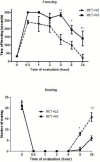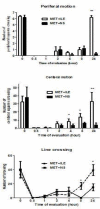Exploring the effect of intravenous lipid emulsion in acute methamphetamine toxicity
- PMID: 28293389
- PMCID: PMC5339653
- DOI: 10.22038/ijbms.2017.8236
Exploring the effect of intravenous lipid emulsion in acute methamphetamine toxicity
Abstract
Objectives: The increasing use of methamphetamine (METH) in the last decades has made it the second most abused drug. Advancs in the area of intravenous lipid emulsion (ILE) have led to its potential application in the treatment of poisoning. The present study aims to investigate the potential role of ILE as an antidote for acute METH poisoning.
Materials and methods: Two groups of six male rats were treated by METH (45 mg/kg), intraperitoneally. Five to seven min later, they received an infusion of 18.6 ml/kg ILE 20% through the tail vein or normal saline (NS). Locomotor and behavioral activity was assessed at different time after METH administration. Body temperature and survival rates were also evaluated. Brain and internal organs were then removed for histological examination and TUNEL assay.
Results: ILE therapy for METH poisoning in rats could prevent rats mortalities and returned the METH-induced hyperthermia to normal rates (P<0.05). ILE reduced freezing and stereotyped behaviors and increased rearing responses (P<0.05). Locomotor activity also returned to control levels especially during the last hours of the experiment. ILE administration decreased the prevalence of pulmonary emphysema in the lungs (P<0.05 and P<0.01) and percentages of TUNEL positive cells in the brain (P<0.05), in comparison with the control group.
Conclusion: ILE could reduce the severity of METH- induced toxicity as well as mortality rate in the animals. Intravenous infusion of lipid emulsion may save the life of patients with acute METH intoxication who do not respond to standard initial therapy.
Keywords: Acute toxicity; Antidote; Intravenous lipid emulsion; Methamphetamine.
Figures








Similar articles
-
Effect of Intravenous Lipid Emulsion on Clozapine Acute Toxicity in Rats.J Pharmacopuncture. 2019 Sep;22(3):147-153. doi: 10.3831/KPI.2019.22.019. Epub 2019 Sep 30. J Pharmacopuncture. 2019. PMID: 31673444 Free PMC article.
-
The effects of intravenous lipid emulsion on prolongation of survival in a rat model of calcium channel blocker toxicity.Clin Toxicol (Phila). 2015 Jul;53(6):540-4. doi: 10.3109/15563650.2015.1045979. Epub 2015 May 18. Clin Toxicol (Phila). 2015. PMID: 25984591
-
Promising effects of intravenous lipid emulsion as an antidote in acute tramadol poisoning.Reg Anesth Pain Med. 2013 Sep-Oct;38(5):425-30. doi: 10.1097/AAP.0b013e31829f644b. Reg Anesth Pain Med. 2013. PMID: 23900052
-
What are the adverse effects associated with the combined use of intravenous lipid emulsion and extracorporeal membrane oxygenation in the poisoned patient?Clin Toxicol (Phila). 2015 Mar;53(3):145-50. doi: 10.3109/15563650.2015.1004582. Epub 2015 Jan 29. Clin Toxicol (Phila). 2015. PMID: 25634667 Review.
-
Intravenous lipid emulsion to reverse acute drug toxicity in pediatric patients.Ann Pharmacother. 2013 May;47(5):735-43. doi: 10.1345/aph.1R666. Epub 2013 Apr 23. Ann Pharmacother. 2013. PMID: 23613099 Review.
Cited by
-
Use of intravenous lipid emulsion therapy as a novel treatment for brevetoxicosis in sea turtles.Sci Rep. 2021 Dec 17;11(1):24162. doi: 10.1038/s41598-021-03550-y. Sci Rep. 2021. PMID: 34921188 Free PMC article.
-
Aerobic training and vitamin E administration ameliorates cardiac apoptosis markers in rats exposed to methamphetamine.Eur J Transl Myol. 2023 Dec 11;33(4):12112. doi: 10.4081/ejtm.2023.12112. Eur J Transl Myol. 2023. PMID: 38112583 Free PMC article.
-
Thymoquinone abrogates methamphetamine-induced striatal neurotoxicity and hyperlocomotor activity in mice.Res Pharm Sci. 2021 Jun 30;16(4):391-399. doi: 10.4103/1735-5362.319577. eCollection 2021 Aug. Res Pharm Sci. 2021. PMID: 34447447 Free PMC article.
-
A review of basic to clinical studies of the association between hyperammonemia, methamphetamine.Naunyn Schmiedebergs Arch Pharmacol. 2022 Aug;395(8):921-931. doi: 10.1007/s00210-022-02248-w. Epub 2022 May 23. Naunyn Schmiedebergs Arch Pharmacol. 2022. PMID: 35604430 Review.
-
The effects of vitamin B12 on the brain damages caused by methamphetamine in mice.Iran J Basic Med Sci. 2018 Apr;21(4):434-438. doi: 10.22038/IJBMS.2018.23362.5897. Iran J Basic Med Sci. 2018. PMID: 29796230 Free PMC article.
References
-
- Cadet JL, Krasnova IN, Jayanthi S, Lyles J. Neurotoxicity of substituted amphetamines: molecular and cellular mechanisms. Neurotox Res. 2007;11:183–202. - PubMed
-
- Cruickshank CC, Dyer KR. A review of the clinical pharmacology of methamphetamine. Addiction. 2009;104:1085–99. - PubMed
-
- Davis GG, Swalwell CI. The incidence of acute cocaine or methamphetamine intoxication in deaths due to ruptured cerebral (berry) aneurysms. J Forensic Sci. 1996;41:626–8. - PubMed
LinkOut - more resources
Full Text Sources
Miscellaneous
